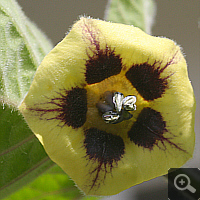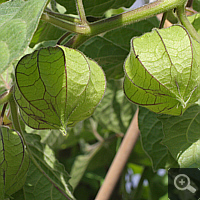Cape Gooseberry (Physalis peruviana)
Overview
You know the Cape Gooseberry from the fruit section of the supermarket. Originally home of this Nightshade plant (Solanaceae) is South America. The little orange berries are sourish and very tasty.
Description
The Cape Gooseberry qucikly grows up to a branched, up to 1,5 metres high shrub. The leaves are cordiform, smooth and slightly hirsute. At a height of circa 40 centimetres the main sprout branches off the first time. The first blossom arises from this distribution point. Thereafter the sprouts branch off each anew after circa ten centimetres. Also here a blossom arises from the distribution point. Thus flower formation shows an exponential development. For example, after six fissions 32 blossoms are existing, after the seventh fission 64 and so forth.
Culture
Culture is unproblematic. Give the seeds a few millimetres within potting compost. Within a few days the germ buds appear, prick and plant them out after the icemen. High nutrient and water demand. A partial covering with plastics, like in the case of tomatoes, to hasten growth is an asset.
Experiences
I have already repeatedly grown Cape Gooseberry plants, which each year have more or less successful fruited. In the case of Cape Gooseberry is the short vegetation period in Germany the greatest problem. Because of the exponential flower formation it is important to „make a run“ as soon as possible. Sow the seeds already in January or February, only so you will have far enough developed plants, which will produce more than a handful fruits until autumn. After the icemen the Cape Gooseberry can be planted out, a slight covering with plastics is an advantage, because so growth is hastened. A pollination by insects happens almost to hundred per cent. Fruits are ripe when the husk is brownish and completely dried up.
2009
I made a try at biennial culture – with a frustrating result. The plants are to overwinter light and cool without any problems, but they show during their second year a lack of vitality. Growth is extremely hesitant, all in all the plant makes a peaky impression, so that I recommend you in any case an annual culture.
2011
This year I grew in January again plants from seeds. In the case of an early sowing the plants blossom already in May and bear already in June some fruits. The annual culture is just as unproblematic as with tomatoes.



